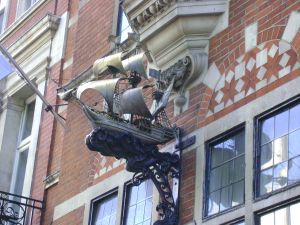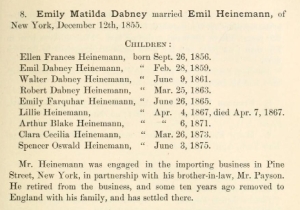At 20 Buckingham Gate an unusual stepped gabled house is now occupied by the High Commission of the Kingdom Of Swaziland, but the first occupant was Emil Heinemann, a wealthy banker. The house was designed by Reginald Blomfield.

Photograph by Robert Freidus via victorianweb.org
Who was Emil Heinemann?
In the 1891 census, we find him at 104 Eaton Square, together with his wife Emily, his daughter Clara C. (18 years old) and his son Spencer O. (15 years old). Also listed are 12 [!!] servants: 9 female ‘domestic servants’, a butler, a footman, and a groom. Emil is 49 years old and was born in Hannover, Germany. Emily is one year younger and born in the US. The children were born in Sussex Wellington. This turns out to have been Willingdon, Sussex. The 1881 census shows the Heinemann family living in that village in Ratton House. In 1881, there are 11 servants, some of whom are the same as in the 1891 census, so presumably they were quite satisfied with serving the family and moved with them to London. Besides Spencer and Clara, two more children are present, Emily F. (15 years old) and Arthur B. (9 years old). These children were born in the US. Clara is also listed as born in the US, so one of the censuses is at fault. What is clear, however, is that the Heinemanns spent a long time in America and indeed, we can find a complete list of the children in a family record by G.F. Jones(1):
Mrs Emily Heinemann was born on Rhode Island on 9 January 1833, the daughter of Charles Henry Dabney and Ellen Maria Jones. Emil was born on 2 March, 1832 in Osterode, just south of Hannover. According to G.F. Jones, he lived in New York and Rhode Island from 1854 to 1874 and he is “now [that is in 1884] a banker in London, and senior partner of Blake Brothers & Co.” That firm was liquidated at the end of 1885. (2)
According to George F. Chambers in his East Bourne Memories of 1910, Ratton House, Willingdon was let to the Heinemanns from 1874 tot 1881. Heinemann, given as ‘Justice of the Peace for Sussex’ in the 1881 census, wanted to buy the house, but it was not for sale. Chambers adds a little aside to the mention of the Heinemann family, “I dare not print any anecdotes of that period of the world’s history, though I am sorely tempted to give one in particular”. Well, well, what would be so sensitive he could not print it? We shall probably never know. The electoral registers show Emil at the 104 Eaton Square address from 1883 to 1891 and from 1893 at 20 James Street, Buckingham gate. He died on 18 November 1901 at St. Leonard’s-on-Sea and his executors were Emil Dabney Heinemann, esquire (the eldest son), Spencer Oswald Heinemann, civil engineer (the youngest son) and the reverend Francis Clyde Harvey (son-in-law).(3) The London Gazette of 24 January, 1902, gives the address of Emil Dabney and Spencer Oswald as 20 Buckingham Gate. The reverend Harvey lives at Hailsham, Sussex and is the husband of the eldest daughter Ellen Frances. The estate at the time of the probate was valued at just over £174.744. This corresponds quite nicely with the figure of £170,798 given by W.D. Rubinstein in his “Jewish top wealth-holders in Britain 1809-1909”.(4)
We may gather from the above, that the Heinemanns came to London somewhere in the early 1880s and moved to the Buckingham Gate address between 1891 and 1893. This is a bit earlier than is usually attributed to the building at 20 Buckingham Gate (1895), but of course we do not know whether Heinemann actually lived in the building at the time of the 1893 electoral registration, although the designation in the register as ‘dwelling house’ seems to suggest that.
Who was the architect?
Reginald Theodore Blomfield (1856-1942) was the grandson of bishop Charles Blomfield of London and trained with his uncle A.W. Blomfield and attended the Royal Academy Schools. After a few months travel in Europe, he started his own business in 1883. His early work, among which the Heinemann house at Buckingham Gate, was in the so-called Queen Anne Revival style. His later designs lean more towards the classical style as for instance the most well-known example of his work, the Menin Gate at Ypres. He was also heavily involved in the Arts & Craft movement and hence in the Art Workers Guild.(5)

Drawing by W. Curtis Green. Source: R.A. Fellows, Sir Reginald Blomfield, an Edwardian Architect, 1985
The house is a Grade II listed building and is described as a substantial terraced house with the following characteristics:
Red brick, stone dressings, slate roof. Flemish manner with stepped gable. 4 storeys, gable storey and basement; irregular facade. 2 main bays. Entrance in archway to left with carved capitals and tiny domed oriel over. To right a wide projecting square cornered bay window rising from basement to second floor, with tented copper roof and polygonal oriel to first floor with copper half-dome and finial. Mullioned and transomed windows, casements, leaden lights. Rich decorative frieze of carved brickwork with figures and acanthus scroll. Stepped gable with Seralin window and central column above rising to finial. Pinnacles to sides. Patterned blind arches above some of windows with polychrome decoration. Ornamental metal ship emblem to right above ground floor. Elaborate leadwork. Wrought iron railings of original design.(6)
The carved brick frieze of ‘the bather’ is attributed to Henry Alfred Pegram (1862-1937). Pevsner et al. noted that the building was called Ship House and that the name and the emblem must predate the currant occupant, although they could not give a logical explanation for it.(7) As we can see from Curtis Green’s drawing, the ship has not always been on the house, so presumably an early 20th-century owner adorned the house with it.

(1) George Farquhar Jones, Family Record of the Jones Family of Milford, Massachusetts, and Providence, Rhode Island, 1884, p. 99.
(2) London Gazette 1 January, 1886. The address of the firm was No. 62, Gresham House.
(3) England & Wales, National Probate Calendar (Index of Wills and Administrations), 1901.
(4) In Transactions of the Jewish Historical Society of England, vol. 37, 2002, p. 153.
(5) For more on Blomfield see Wikipedia and R.A. Fellows, Sir Reginald Blomfield, an Edwardian Architect, 1985
(6) britishlistedbuildings.co.uk
(7) Nikolaus Pevsner. The Buildings of England, ‘The Cities of London and Westminster’, 1952.






very interesting post.
Thank you.
I was walking down memory lane and came across this very informative post.
I was looking for Ship House because I worked in that building from 1990 to 1995 for the United Nations Office and Information Center.
The story behind the ship (taken with a grain of salt, of course since it is probably purely conjecture) is that the house was owned by a captain who bought Ship House for his mistress.
Thanks Heather, nice to hear that there is an explanation for the ship. Maybe it isn’t true, but it is a likely story.
Pingback: The tomb of William Rawlins | London Details